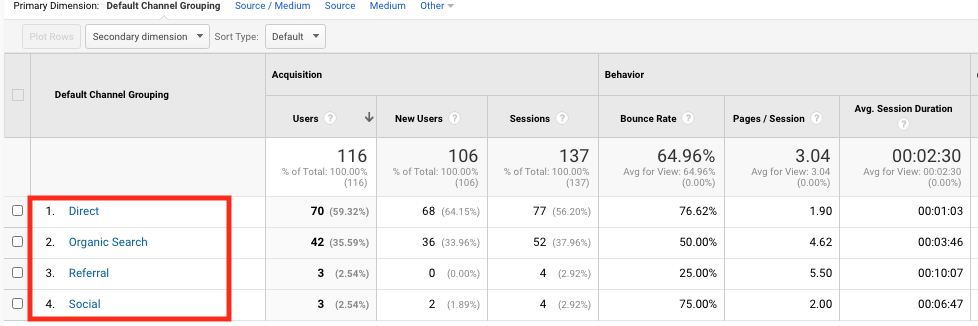In today’s increasingly competitive online market, understanding how your visitors and customers behave on your website is the most crucial piece of data you need. Google Analytics is a leader in web analytics, which tracks and records a multitude of dimensions (like demographics, location, the device used, etc.) on your website for free.
Without behavior data, you’ll probably struggle to identify how to boost your website’s performance. Which page receives the most visits? Perhaps you want to know how long people spend on each page, or which blog article resonates with your readers. Through more relevant snippets of data, you’ll have more opportunities for optimization, brainstorming new ideas, and understanding how every component on your website connects to your sales funnel.
So, What’s the Deal with Web Traffic?
As website owners or marketers, we think of “traffic” in terms of “users” or “visitors” landing on a page of your website. Google Analytics’ tracking code automatically captures the traffic medium, source, and marketing campaign name when a user visits your website. The “Source,” for instance, will tell you where your website’s traffic comes from (specific websites, Google, Twitter, etc.) while the “Medium” reveals the type of traffic (organic, direct, referral, paid, etc.).
Organic Traffic
Organic Traffic refers to traffic that arrived on your sites through unpaid searches from Google, Bing, Yahoo, and other search engines. Organic traffic is free and can be targeted, which may come from SEO efforts to rank the website as high as possible in Google’s all-important Search Engine Results Pages (SERPs). One way to increase your organic traffic is through SEO, search engine optimization, to help search engines categorize and rank your website’s content based on the specific keywords and combinations within your website.
Direct Traffic
Google Analytics defines direct traffic as website visits that arrive at your website when a user either types your website URL into a web browser or recalls the URL through a browser’s bookmark. Unfortunately, Google Analytics also categorizes any unrecognizable source as direct or none.
Direct traffic often presents a quandary for marketers because of this catch basket result. Several factors can generate direct traffic. One example is direct traffic growth resulting from fellow employees’ visits without your IP address filtered from Google Analytics. Other reasons include:
- Bot Traffic
- Users going to a non-secure (HTTP) site from a link on a secure (HTTPS) site
- Improper Redirects
- Non-web documents (PDF, Word, etc.)
- Missing GA tracking codes
- Clicking on shortened URL links
Referral Traffic
Referral Traffic describes website sessions produced by users clicking from a third-party website rather than on a search engine. Referral traffic is valuable in online marketing because it sends interested readers and qualified potential customers to your site from new domains. Common sources of referral traffic include:
- Press Releases
- Guest Posts/Blogs
- Business Directories
- Industry Associations
- Social Bookmarking sites like Reddit, Digg, Slideshare, and Quora
- Social Networking sites like Facebook, Twitter, LinkedIn, and Pinterest
More importantly, referral traffic can generate quality leads on your marketing initiatives. According to Google Analytics Specialists, referral traffic occurs due to repeat website visits or through word-of-mouth marketing – people are showing interest in your brand. Nevertheless, landing directly on your site doesn’t necessarily mean visitors are ready to transact immediately. The majority of your leads – even those acquired through direct traffic – will still require some nurturing.
Paid Website Traffic
Paid Traffic only applies to businesses running PPC advertising campaigns. Paid traffic is any customer that visits your website by clicking through one of your Google paid search, display, or other surface ads.
Optimizing Your Website with Data from Google Analytics
The goal of Google Analytics is to help you as a business owner to deliver a high-quality website to your customers and provide you with all the necessary information regarding the website statistics.
Digging further into your website traffic and looking at hourly traffic allows you to get a better understanding of how and when people are using your website. Once you gather a significant amount of traffic data, you can make better-informed decisions, such as:
- When to post blog content, as well as the types of content you should publish
- When and where to implement changes to your website
- How your target audience searches and uses the Internet before landing on your website
By harnessing Google Analytics, you can identify the loopholes in your website design, content or structure, and make the necessary adjustments. Google Analytics provides you with a blueprint for giving your visitors what they want when they want it. So make sure you listen to the data!
For more Google Analytics help and a better understanding of metrics, make sure to bookmark our blog. If you want to drive quality traffic to your website, contact the experts at Premiere Creative or give us a call at (973) 346-8100.


